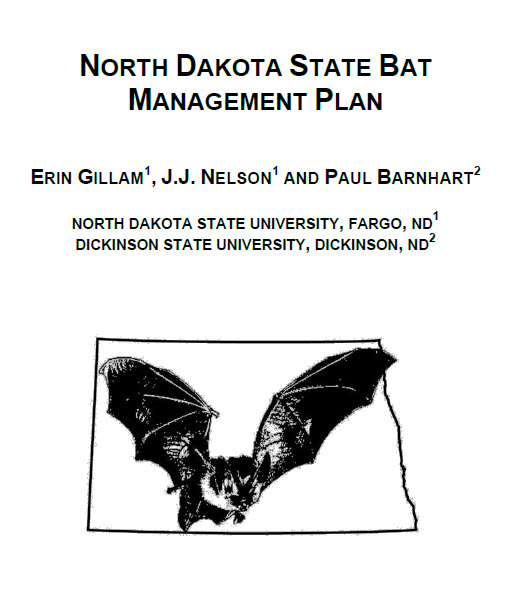North Dakota State Bat Management Plan
Bats are an integral part of a healthy ecosystem, providing key ecological and economic benefits. As the threats to bat populations from factors such as anthropogenic development and emerging infectious disease continue to rise, a concerted effort at appropriate conservation and management is needed. The North Dakota Bat Management Plan represents the first step in that effort for our state, identifying what we already know about local and regional bat populations, as well as key objectives that should be met in coming years.
The first part of the ND Bat Management Plan provides basic information on the natural history of bats for those that may be unfamiliar with this group of mammals. This includes a discussion of basic life history characteristics, foraging and roosting ecology, and other pertinent biological information. We also discuss topics related to the interactions between humans and bats, such as the economic importance of bat populations and the threat of rabies transfer from bats to humans. This section ends with a brief description of the species comprising the ND bat community and an overview of previous bat research that has been conducted in the state. The second part of the document addresses the primary goal of the plan, which is to outline the major threats to bats in the Great Plains region and provide direction about specific needs in the area of management, research and education. For each of these areas, we include: 1) an explanation for why more information is needed, 2) a list of objectives, and 3) an outline of strategies for meeting these goals. We encourage managers to adapt these objectives and strategies to their local ecosystems and information needs.
Finally, we provide managers and researchers with tools for studying the bats of North Dakota, including: 1) detailed species accounts, 2) a taxonomic key for identifying captured bats, 3) an acoustic key summarizing five years of monitoring in the state, 4) the USFWS WNS decontamination protocol, and 5) habitat suitability maps for eight of the eleven bats species resident in the state.
Our long-term goal is that the ND Bat Management Plan be a living document that is regularly updated as the conservation and management needs of bats within the state change over time. Regular input from NDGF employees, as well as managers and scientists from federal agencies, tribal agencies, colleges/universities, and the general public will be valuable for identifying which strategies have been effective and for setting future goals and objectives. While such a scenario would make this a fluid document that slowly changes over time, we recommend a full assessment and appropriate revision occur at least every five years.

